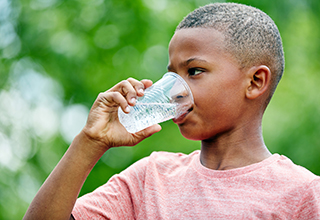A new study done by NIEHS-funded researchers at Brown University, led by Joseph Braun, finds exposure to PFAS is assoicated with alterations in metabolic pathways related to metabolism in a cohort of children in the Cinncinnati area.

A new study done by NIEHS-funded researchers at Brown University, led by Joseph Braun, finds exposure to PFAS is assoicated with alterations in metabolic pathways related to metabolism in a cohort of children in the Cinncinnati area. The research, part of a long term NIEHS-funded cohort study, is published in the journal Metabolomics.
Early life exposure to PFAS is particularly important to better understand in children, as these vulnerable populations are often more suceptible to the effects of being exposed to things in their environment, like PFAS, given their small bodies and underdeveloped immune systems.
Studies such as this have been done in a group of adult Chinese men, older adults from Sweden, and two animal studies done in mice. This research builds on exisiting work in this area by looking at metabolomic responses to PFAS in a general population of children.
The research team investigated four sub-species of PFAS (PFOA, PFOS, PFNA, and PFHxS) – all of which have an estimated half-life, or time for the chemicals to start breaking down, of 3.8 - 8.5 years in humans. These four PFAS also collect in human tissue over time, known as bioaccumulation.
Pregnant women enrolled in the previously-established Health Outcomes and Measures of the Environment (HOME) study consented to allow their children to be part of the study at eight years of age. At the time of their eight-year clinic visit, blood was drawn from the children and sent to the lab to measure serum concentrations of the four PFAS.
The researchers found that serum PFOA, PFOS, PFNA, and PFHxS concentations were associated with pathways related to amino acid and lipid metabolism, suggesting that PFAS may be altering the energy balance in exposed children.
Despite the differences in methodology and study design, the researcher’s results were consistent with previous studies done in human cohorts and animal studies examining metabolic responses to PFAS exposure.
Citation: Kingsley SL, Walker DI, Calafat AM, Chen AM, Papandonatos GD, Xu YY, Jones DP, Lanphear BP, Pennell KD, Braun JM. 2019. Metabolomics of Childhood Exposure to Perfluoroalkyl Substances: A Cross-sectional Study. Metabolomics 15(7). doi 10.1007/s11306-019-1560-z. [Abstract] [R01ES025214]


